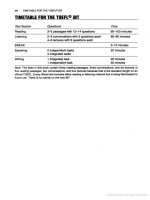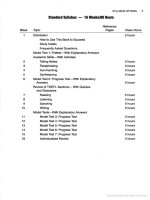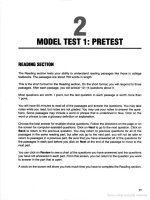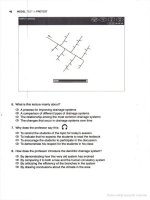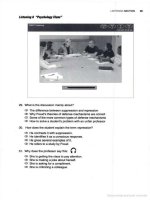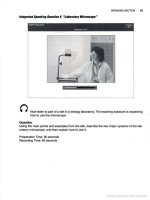Toefl ibt internet based test 2006 - 2007 part 5 pps
Bạn đang xem bản rút gọn của tài liệu. Xem và tải ngay bản đầy đủ của tài liệu tại đây (793.66 KB, 7 trang )
MODEL
TEST
1:
PRETEST
READING
SECTION
The Reading section tests
your
ability
to
understand reading passages like those In coltege
textbooks, The passages
Bre
about 700 words
In
length.
This
Is
the short
formalior
the Reading section.
On
the short format, you will respond to three
passages,
After
eadl
passage, you will answer
12
-
14
questions about it.
Most
questions
are
worth 1 point,
but
the last question in eaen passage is worth more than
1 point
You
willl\ave
60
minutes
to
re
ad all
01
the passages
and
answer the
qu
estions.
You
may
lake
nptes while you read,
but
notes are not graded.
You
may use your ootes to answer the ques-
tions.
Some
passages
may
include a
WOfd
or
phrase thai is underlined
In
blue. Click
on
the
WOfd
or
phrase
to
see a glossal)' definition
or
explanation.
Choose the
beslanswer
l
or
m uhiple cholce queslJons. Follow the directions
on
the page
or
on
the
screen
lor
computeJ-asslsled
questions. Click
on
Next
to
go
to
the
08;(1
question, Cl
ic
k
on
8Kk
to
rewm
to
the
previou
s
question
. You
may
return
to
previouS questions
lor
all
01
the
passages in the same reading part, but after you
go
to
the next part, you will not
be
able
to
return
to
passages In a previous
pa
rt
.
Be
sure that you have answered all
01
the
questions
fOf
the passages in
each
part before you click
on
Next
attha
end
of the passage to
move
to
the
next part.
You
can click
on
Review
to
see
a chart
of
the questions you
have
answered
and
the questions
you
hav
e
not
answered in
each
part. From this screen, you can return
to
the question you want
to answer In the part that Is open.
A clock
on
the screen will
show
you
how
much time you have to completa
the
Reading section.
"
22
MODEL
TE
ST 1: PRETEST
PART
I
11M'.,
f
If
"
HI.torical
Back
g
rou
nd
-+
The epic poem Beowulf, written
In
Old English, is
the
earliest e)(isting Ger-
manic
epic
and
one
of
lour
survivi
ng
Anglo-Saxon
manuscripts. Although
Beowuff was written by
an
anonymous Englishman in Old English, the tale
takes place in that part
of
Scandinavia from
_Germanic
tribes emigrated to
England. Beowulf comes
from
Geattand,
the
southeastern part of what
Is
now
Sweden. Hrothgar, king
of
the Danes, lives
near
what is
now
Lelre, on Zealand,
Denmark's largest island. Tha Beowulf epic contains three
map"
tales about
Beowulf and several minor tales that reHect a rictI Germanic oral tradition of
myths, legends, and folklore.
-+
The BeoltVff warriofs have a foot in both the Bronze and Iron Ages. Thair
mead-halls reflect
the wealthy living
of
the Bronze Age Northmen, and their
wooden shields, wood-shafted spears, and bronze-hilted swords
are
those of
the Bronze Age warrior. However, they
carry
Iron-tipped spears, and their best
swords have iron
or
iron-eclged blades. Beowulf also
orders
an iron shield
lor
his fight with a dragon. Iron replaced bronze because it produced a blade
with
a cutting edge that was stronger and sharper.
The
Northmen leamed
how
to
lorge
iron in about
500
B.C. Although they had
been
superior to the European
Celts in bronze
work
, it was the Celts
who
taught them
how
to
make and design
iron
worK. Iron was accessible everywhere
In
Scandinavia, usually In the form
01
"bog-iron" lound in the layers of peat
in
peat bogs.
The
Beowuff epic
also
reveals int&fasting aspects of
the
lives
01
the Anglo-
Saxons woo lived
In
England
at
the time of the anonymous Beowuff poet. The
Germanic tribes, including the Angles, the
Saxons, and the Jutes, invaded
England from about
A.O.
450 to 600_
-+
Although
the
BeoltVlfmanuscript
was written in about
A.D.
1000,
it was not
discovered until the seventeenth century.
[!l
Scholars do not know whether
BeoltVffls
the sole surviving epic from a flourishing Anglo-Saxon lit&fary period
that produced other
great
epics
or
whether It
was_
even In
Its
own time.
!CJ
Many scholars think that
the
epic was probably written
sometime
between
the late seventh century
and
the early ninth century. It they are
COITec!
, the
ong-
Inal manuscript was probably lost during the nlnttHlentury Viking Invasions of
Anglia, in which the Danes desltoyed tna Anglo-Saxon monasteries and their
great libraries. However, other scholars think that the poet's favorable attitude
toward the Danes
rrnJst
place the epic's composition after the Viking Invasions
and
at
the stan of the eleventh century, when this BeoItVIf manuscript was
wrinen.
,",,,,,,,,,ttet
mater<aie
READING
SECTION
23
-+
The identity of the
880wuff
poet is also uncertain.
IQ]
He apparently was a
Christian
who Joved the pagan heroic tradition of his ancestors and blended the
values of the pagan
hero
with the Christian values
of
his own country and time.
Because
he
wrote in
the
Anglian dialect,
he
probably was either a monk in a
monestery
or
a poet in an Anglo-Sa:w:on court located north of the Thames
River.
Appnl
a
nd
Value
BBowuff interests contemporary readers for many reasons. First, it is an
outstanding adventure story. Grendel, Grendel's mother, and the dragon are
marvelous characters. and each fight is unique, action-packed, and
e:w:citing.
Second,
Beowulf
Is
a
very
appealing hero. He
Is
the perfect warrior, combining
elctraordinary strength, skill, courage, and loyally.
Uke
Hercules,
he
devotes his
life to making the work! a safer place. He chooses to risk death in
order
to help
other people, and
he
faces his inevitable death with heroism and dignity. Third,
the
Beowuff
poet is interested
In
the psychological aspects of human behaviOr.
For
e:w:ample,
the Danish hero's welcoming speech illustrates his }ealousy of
Beowulf.
The
behaviOr of Beowulf's warriors In the dragon fight reveals their
cowardice. Beowutl's attitudes toward heroism reflecl his maturity and
e:w:peri
-
ence, while King Hrothgar's attitudes toward life Show the
e:w:periences
of an
aged nobleman.
Anally,
the
Beowulf
poet a mature
awedation
of the transitory
nature of human life and
In
Beowulf, as in the major epics of
other cultures, the hero must create a meaningful life in a world that is olten
dartgefous
and uncaring.
He
must
acceptlhe
inevitability of death. He chooses
to
~despal
r
;
instead, he takes pride
In
himself and In his accomplishments,
and
1M;
values human relationships.
1. According to
paragraph!
, which of the following is true about 880wuln
<D
It
is the only manuSCfipl from the Anglo-Saxon period.
<D
The
original story
was
written
In
a German dialect.
<t>
The
author did
nol
sign his name to the poem.
<D
It
is
one
of several epics from
the
first century.
Paragraph!
is marked with an arrow 1
-+
1.
2. The word
wtllI::b
In
the passage refers
10
Gt>
tale
<D Scandinavia
<t>
manUSCfipls
<D
Old English
yttet
matcr<8~
2"
MODEL
TEST
1: PRETEST
3. Why
does
the
author mention "bog-iron" in paragraph
2?
CD
To demonstrate tile availability
01
iron in Scandinavia
<D
To prove that iron
was
better than bronZe l
or
weapons
(0
To
argue that the Celts provided the materials
to
make
Iron
CD
To
suggest that 500 B
.C
.
was
the
date that
the
Iron
Age
began
Paragraph 2 is
marlled with:
an
arrow [
-+
].
4. Which
oj
the
sentences
below
besl expresses the information in
the
highlighted statement
in
the passage?
The
other
choices
change the meaning
or
leave out imJXlflant information.
CD
Society in Anglo-Saxon England
was
both advanced and cultured.
<D
The society
of
the Anglo-Saxons
was
not primitive
or
cultured.
(0
The Anglo-Saxons had a society tIlat
was
primitive, not cultured.
CD
England during the Anglo-Saxon society
was
advanced, not cultured.
5.
The
word unique in the
passage
is
closest
In
meaning to
<l>
o.
<D
fare
(0
perfect
CD
weak
6. According
to
paragraph 4,
why
do
many
scholars
be
lieve that
the
original manuscript for
Beowuff
was
lost?
CD
Because it
is
not like
other
manuscripts
<D
Because
many
libraries were burned
(0
Because
the
Danes
were
allies
01
the Anglo-Saxons
CD
Because
no
copies
were
found In
monas
teries
Paragraph 41s marlled with an arrow [ j.
7. In paragraph 4, the author suggests that Beowuffwas discover
ed
in
the
CD
first cantu!)'
<D
ninth cantu!)'
(0
eleventh cantu!)'
CD
seventeenth cantu!),
Paragraph 4
1s
marlled with
an
arrow [
-+
].
,",,,,,,,,,tlet
mater<ale
REAOING
SECTION
2$
8.
Why
does
the
author
01
this passage use the word "apparently" in paragraph 51
(D
He
Is
not
certain that the autnar of
BeowuH
was a Christian.
(J)
He Is mentiOning fact
s.
that are obviOus to the readers.
<D
He
is giving an example from a historical reference.
<D
He
is Introducing evidence about the autnar of
BeowuH.
Paragraph 5 is marKed with an arrow [
-+
].
9. The author compared tile Beowulf character to Hercules because
(D
they are both examples of the ideal hero
(J)
the
ir
adventures with a dragon are very similar
<D the speeches
that they make are
in
spiring
~
they lived at about the same time
10. The word exhibits in the passage is clQsest
in
meaning to
(D
creates
<];I demonslrates
<D assumes
<D
terminates
11
. The word
~
in the passage
is
closest in meaning to
(D
manage
(J)
evaluate
<D refuse
<D
confront
12. Look
at
the
four
squares [ _ ] that show where the following senlence could
be
inserted in
the passage.
Moreover, they
disagree
as
to
whether this
Beowu"is
a copy
of
an earlier
manuscript
.
Where
could
the sentence baSI
be
ack:ied?
Click on a square [_
110
insert the senlence in the passage.
besk
tlet
matcr.ate
:ze
MOOELTESTI: PRETEST
13. Directions:
An
in
troduction
for
a
short
summary of the passage appears
below.
Complete
the
summary by selecting the THREE answer
choices
that mention the most important
points
in
the passage. Some sentences do not belong
in
the summary because they
express ideas that are
not included
in
the
passage
or
are minor points from
the
passage.
Th
is
quest/on Is worth 2
points
.
Beowulf Is the
oldest
Angl~Saxon
epic poem that has survived
to
the present day.
•
•
•
Answer Choices
!AI
The Northmen were adept
In
crafting
tools
and
weapons made
of
bronze, but
the
Celts were superior
in
designing and
working
In
iron.
[BJ
In
thll Viking invasions of England, thtt
Danish armies destroyed monasteries,
some of
wh
ich contained extensive
libraries.
Itl King Hrothgar and Beowulf become
friends at the end
01
their lives, after
having spent decades opposing each
other
on
the
battlefield.
~
The poem chronicles life In Anglo-Saxon
society during the Bronze and
Iron
Ages
when Germanic tribes were invading
England. .
I£J
Although
Beowulf
was writtan
by
an
anonymous poet, probably a Christian,
about
1000
11.0.,
it
was
not
found until the
seventOO11th
century.
lEI
BBowuff
is still
in
teresting because
it
has
engaging characters,
an
adventurous
plol, and
an
appreciation for human
behavior and relationships.
bas ttel
mat
na
READING
SECTION
27
PART
II
1IaII1., 2
·711er.,,,.,.,,
~
Mammals and birds generally maintain body temperature within a narrow
range
(36-38°C
lor
most mammals and
39-42"C
lor
mosl birds) that Is usually
ooosiderab/y warmer than the environment. Because heat always
llows
Irom a
wa!ll1 object to cooler surroundings, birds and mammals must counteract
lhe
constant heat loss. This maintenance of warm body temperalure depends on
several key
adaptations.
1he
most basic mechanism is the high metabolic rate
01
endothermy itself. Endothe!ll1s
can
produce large amounts of metabolic heat
that replace the
flow
01
heat
to the environment, heat
duction·to match rates
01
heat loss.
~~~~~~~~~!:~~~~~~~~~::~~~~;f
;
~
i i and produce
heat
InStead
01
6If
. This
non
ahl
verlng
th
e
rmogene
ala (
NST)
takes place
throughout the
body, but some mammals also have a tissue called
brown
fat in
the neck and between the shoulders that is specialized for rapid heal produc-
tion. Through shivering
and
NST, mammals and birds
in
cold environments can
Increase their metabolic
heat
production by as much as
5to
10 times above the
tiiliimiJ levels that occur in warm conditions.
-+
Another major thermoregulatOf)' adaptation that evolved
in
mammals and
birds is insulation (hair,
feathers, and fat layers), which
reduces
the
flow
of heat
and
Iow8fs the energy
cost
01
keeping wa!ll1. Most land mammals and birds
react to oold by raising their fur
or
fe
athers, thereby trapping a thicker layer of
ak
!AI
Humans rely more on a layer of fat just beneath the skin
RiO
insulation;
goose
bumps
are
a vestige of hair-raising letl over from
our
furry ancestors.
1m
Vasodilation and vasoconstriction also
~
heat
eJ:change and
may
contribute to regional temperature diff8f&f1C8s within the animal.
ICl
For
8J:am
·
pie, heat loss from a
human
is reduced when
a!ll1S
and legs cool to several
degrees below the temperature 01 the body
COfe,
where most vital organs are
located.
!Dl
-+
Hair loses most of its insulating power when wet. Marine mammals such as
whales and seals have a very thick layer of insulation fat called blubber, just
under the skin. Marine mammals swim
in
water colder than their body core tem-
perature, and many species spend
at
least part
01
the year
In
nearly freezing
polar seas. The loss
01
heat
to water occurs
50
to 1
00
times more rapidly than
heat
loss to air, and
tl"le
skin temperature of a marine mammal is close
to
wa
t
er
temperatur
e.
Even so, the blubber insulation is so effective thai marine mam·
mals maintain body core tempefatures of about
36-38
·C with metabolic rates
about the same
asJliiiiof
land mammals of similar
si~e.
The flippers or tail of
a whale
or
seal lack insulating blubber. but countercurrent
heat
exchangers
greatly reduce heat loss
in
these extremities, as they do in the legs of many
birds.
ytlet
matcr<8~

